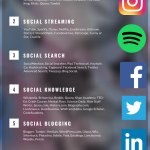Understanding the Different Types of Advertising
Advertising is a crucial marketing technique used by businesses to communicate with their potential customers, and it comes in various formats. In this section, we will delve into the specifics of the different types of advertising, enabling you to grasp which methods might be best for your business growth.
Traditional Advertising
Traditional advertising dates back to the early periods of mass communication. It includes various forms such as television, radio, print like newspapers and magazines, outdoor billboards, and direct mail. Even though digital marketing has become prevalent, traditional advertising still encompasses a significant part of a company’s advertising strategy due to its broad and diverse reach.
Digital Advertising
The digital revolution has paved the way for digital advertising practices that encompass online channels. This type of advertising allows businesses to connect with their consumers in real time, offering a degree of personalization that traditional advertising lacks. Examples of digital advertising include social media marketing, SEM (Search Engine Marketing), PPC (Pay Per Click), email marketing, content marketing, and mobile marketing.
Native Advertising
Native advertising is a form of paid media where the ad experience follows the natural form and function of the user experience in which it is placed. It’s often part of content marketing strategies. These can be articles, infographics, videos that appear on platforms like social media feeds, or as recommended content on a webpage. The key element of native advertising is that it isn’t disruptive and feels less like advertising.
Traditional Advertising Vs. Digital Advertising: What’s the Difference?
In the vast realm of marketing, two types of advertising reign supreme: Traditional Advertising and Digital Advertising. Both offer unique advantages, with their effectiveness often depending on your business’s specific needs and goals.
 Tekashi’s Viral Act of Street Generacy: Unleashing Frenzy Amongst Followers
Tekashi’s Viral Act of Street Generacy: Unleashing Frenzy Amongst FollowersTraditional Advertising
Traditional Advertising refers to conventional modes of communication such as television, radio, newspaper, and billboards. This form of advertising dominated the industry for decades and has the capability to reach a broad audience. However, it often requires a substantial investment and it is challenging to measure the direct impact on the targeted audience.
Digital Advertising
On the other hand, Digital Advertising is a product of contemporary times. It includes various methods like search engine marketing, social media marketing, email marketing, and more. Unlike its traditional counterpart, digital advertising allows businesses to target specific demographics and track their campaign’s effectiveness in real-time. However, the ever-changing digital landscape demands continuous adaptation.
In essence, the main difference between the two lies in their approach to audience reach, cost-effectiveness, and measurability of impact. Determining which is better for your business depends upon your marketing goals, target audience, and budget.
The Influence of Social Media on Modern Advertising
Modern advertising has been significantly transformed due to the pervasive influence of social media. In previous decades, classical modes of advertising such as television and print media were dominant. However, today’s advertising world is increasingly defined by platforms such as Facebook, Twitter, Instagram, and LinkedIn.
The Shift to Social Media Advertising
Advertisers have now shifted their focus to social media, recognizing its importance in reaching a wider and more diverse audience. This change has been driven, in large part, due to the advancements in data analytics provided by social platforms. These platforms capture an immense amount of user data, thereby enabling advertisers to tailor their ads to specific demographic and psychographic segments, making their campaigns more effective and efficient.
 Uncovering the Controversy: What is the Problem with Tekashi 69?
Uncovering the Controversy: What is the Problem with Tekashi 69?Interactive Nature of Social Media
Unlike traditional forms of advertising which are largely one-directional, social media advertising is interactive. It enables potential customers to engage with the content by liking, sharing, and commenting. This interactive nature not only increases the reach of the ads but also provides advertisers with valuable insights on customer preferences, thereby allowing further refinement of marketing strategies.
How Mobile Advertising Became a Game-Changer in the Industry
The advent of mobile advertising has significantly transformed the industry landscape, proving it’s not just a trend, but a true game-changer. Statistics indicate that 52% of all global web pages were viewed on mobile devices in 2018, spotlighting the tremendous outreach potential of mobile advertising. With its capacity to deliver personalized content directly to the users’ handheld devices, mobile advertising offers marketers a platform for interaction that’s uniquely intimate and real-time.
Immediate and Personalized Engagement
The most striking advantage of mobile advertising is its ability to connect with users instantaneously and personally. Traditional mediums fail to provide this level of immediacy and engagement. Mobile advertisements capitalize on user data to offer personalized content, taking consumer engagement to a new level. This dynamic nature of mobile ads enhances the audience’s interaction with the brand, amplifying conversion rates and driving brand loyalty.
The Power of Location-Based Targeting
Another influential aspect of mobile advertising is location-based targeting. This technique leverages geolocation data to deliver location-specific ads to users, creating more relevant and contextually engaging advertising experiences. Location-based targeting enables businesses to deliver the right message at exactly the right time, maximizing the potential for conversion and laying the groundwork for more effective campaigns.
Push Notifications: The Direct Marketing Approach
Moreover, mobile advertising has brought forth a new, direct approach to marketing with push notifications. These little interactive messages show up on users’ mobile device screens, prompting immediate attention. By offering such direct engagement, push notifications have become an indispensable tool in a marketer’s kit, facilitating real-time interaction and boosting customer connection significantly.
 Key Facts and Timeline: When Did Singer 6ix9ine Get Released?
Key Facts and Timeline: When Did Singer 6ix9ine Get Released?Case Studies: Successful Advertising Strategies Across Different Formats
Examining successful advertising strategies through various case studies not only complements our understanding but also opens up a world of creativity and effectiveness in marketing campaigns. When it comes to advertising, it’s crucial to be versatile and flexible, as it involves various formats ranging from traditional print media to digital platforms.
Print Media vs. Digital Advertising
The traditional format of print media advertising still holds significance in certain industries. One such case study involves a leading fashion magazine that utilized innovative layout designs and engaging copy to deliver its brand message effectively. On the other hand, digital advertising has taken the marketing world by storm, thanks to its wider reach and real-time engagement capabilities. An intriguing case study in this space is the use of social media platforms by a startup to skyrocket its customer base within a short span.
The Rise of Video Advertising
Apart from these, another format that is proving to be highly successful in the advertising industry is video advertising. A case study that perfectly illustrates this is a renowned online learning platform that utilized the power of explanatory videos to drive significant user engagement and subscriptions.
Augmented Reality (AR) in Advertising
Advance formats such as Augmented Reality (AR) also deserve a special mention. Brands are increasingly using AR to provide immersive and interactive experiences to their customers. A popular furniture brand’s use of AR to allow users to virtually ‘place’ furniture at their homes before buying is a stellar example of the successful application of this advertising strategy.
Post Relacionados
Essential Characteristics an Effective Advertisement Should Have: Comprehensive Guide
 Understanding the Basics: What is Meant by Advertising?
Understanding the Basics: What is Meant by Advertising?Exploring the Pros and Cons: Advantages and Disadvantages of Advertising
Exploring the Impact: How Does Advertising Influence Society?
Understanding the Basics: What is Advertising and its Crucial Role in Business Success
Exploring Different Types: Comprehensive Guide to What Types of Advertising Exist
Understanding the Basics: What is Content Creation and Its Importance in Digital Marketing
 Understanding Social Media Marketing: What It Is and Why It Matters
Understanding Social Media Marketing: What It Is and Why It Matters